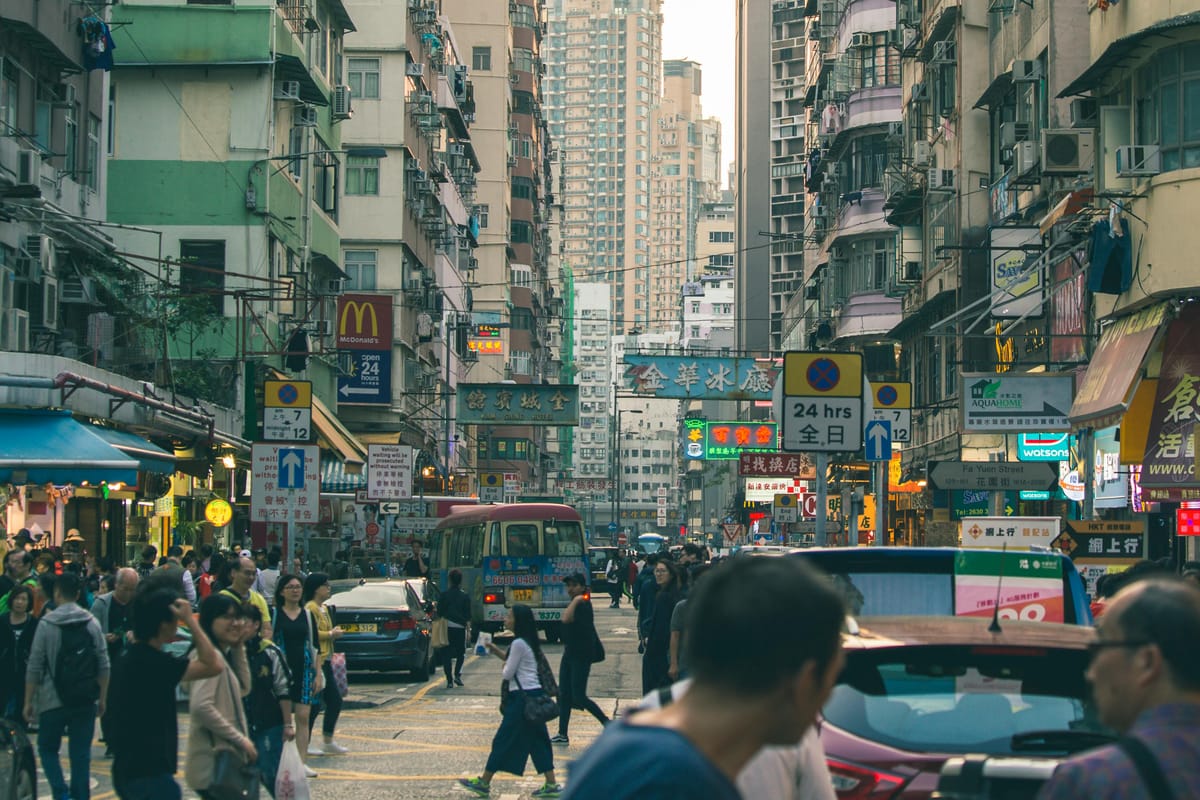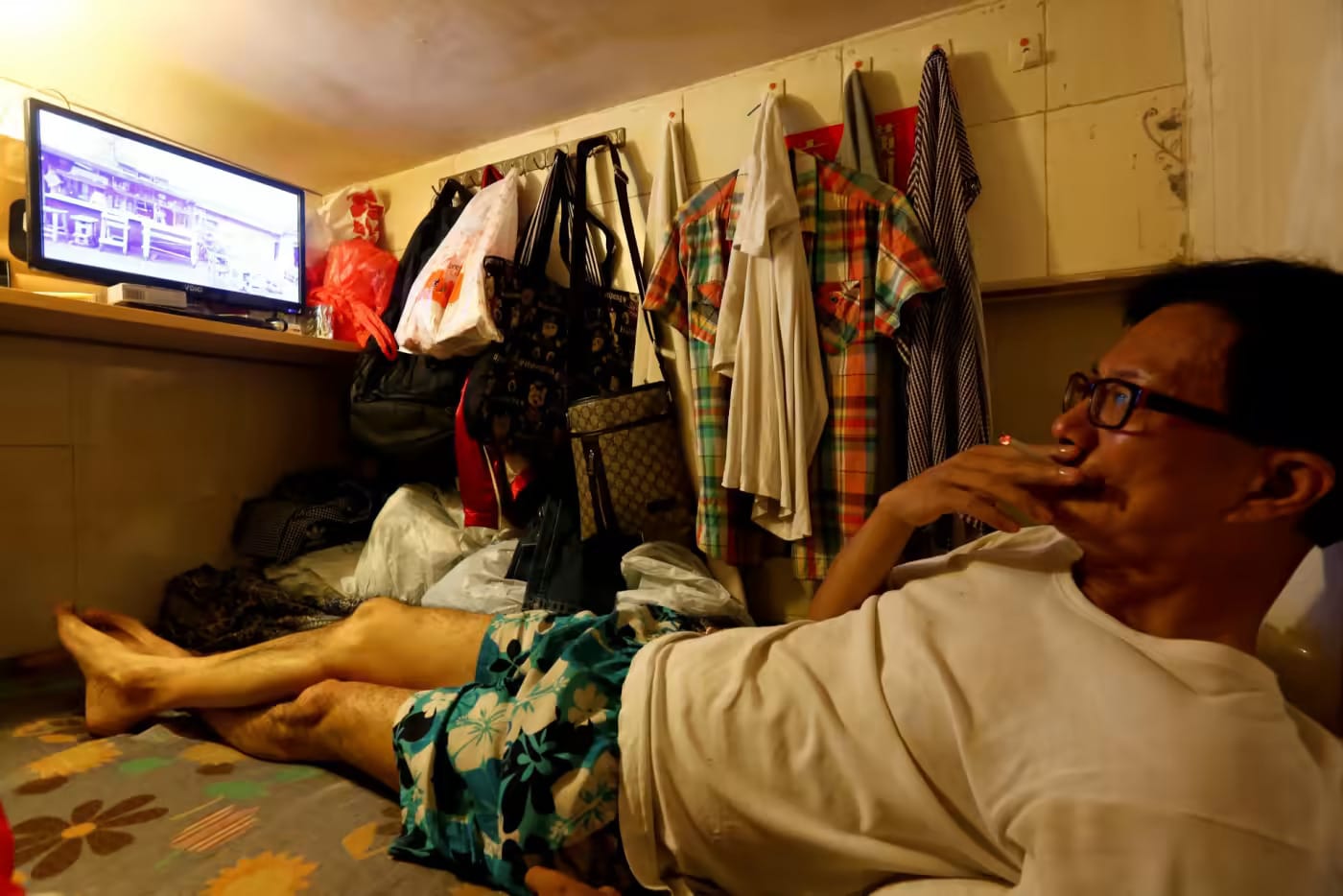What you need to know about Hong Kong's wealth gap
Hong Kong is one of the world's richest economies, but the city's wealth gap is a big deal.

A few minutes every morning is all you need.
Stay up to date on the world's Headlines and Human Stories. It's fun, it's factual, it's fluff-free.
🤔What’s going on?
Hong Kong often ranks as one of the richest economies in the world. But, when looking at the bigger picture, the city still deals with income and wealth inequality. For example, as of 2020, the top 0.001% of the city’s population was making up more than half of its annual income, while the bottom 50% of the income bracket only contributes 11.6% of the city’s revenue, according to Standford’s Center on China’s Economy and Institutions. To put this into perspective, most other countries’ top 0.001% make up less than 35% of the national income.
These stats may be less of a shock when you picture Hong Kong’s iconic coffin homes, where single residents live in what is essentially the same size as a closet, or entire families occupy the space of a typical bedroom.

The Hurun Global Rich List 2024, a ranking of the world's US dollar billionaires for this year, ranks Hong Kong in seventh place globally, with 65 billionaires. On the opposite end of the spectrum, it’s estimated that more than 1.36 million people in the city live in poverty, according to Oxfam, an NGO trying to alleviate global poverty.
A paper from economist Thomas Pickety and Li Yang, a research fellow at the World Inequality Lab, found that a big driver of this wealth inequality was that wages before the 1997 handover grew on average by 7.5% each year, compared to 3.1% in the years up until 2018.
The COVID pandemic seems to have just made things worse. Oxfam found that the poorest 10% of people made 57.7 times less than the richest 10%, which is up from 34.3 times before the pandemic.
“Despite society returning to normal, the problem of wealth inequality has become increasingly serious, and the slow recovery among poor families has sounded alarm bells for society,”said Kalina Tsang, Director General of Oxfam Hong Kong in a press release.
🏡The challenges faced by the underprivileged
The city’s underprivileged population comes from very different situations, meaning improving their quality of life will require many different kinds of solutions.
For example, one of the city’s biggest challenges is how to support a rapidly aging population. You might have heard of Hong Kong’s “cardboard grannies,” who spend their days collecting cardboard and lugging heavy bundles across the city to sell to recycling companies for pennies. With the government expecting the number of people aged 65 or older to double to 2.37 million in 2036, or just over 30% of the population, the problem of an elderly population without enough support could get a lot worse before it gets better – especially if you take into account the falling fertility rate.
Naveen Sadhwani, the Founder of Hanuman Charity, a Hong Kong NGO that provides meals to the city’s underprivileged, explained to TMS that these elderly poor often experience a “feeling of being unnoticed and segregated from the society.” “Insights from our continuous charity walks since the pandemic in Hong Kong reveal that the elderly cardboard collectors want to be noticed, if not appreciated, but at least to be known and feel a sense of belonging to society. Many of them get neglected as they may be ‘dirty, dusty and unclean’ due to the working conditions and environment, compared to the normal working class in Hong Kong,” said Sadhwani.
As for homeless people in Hong Kong, Sadhwani said their situation can make other health problems worse, such as lack of sleep. He also said a common day-to-day stress for many of the city’s poorest people is worrying about having their things stolen.
“Living in such dire conditions, many of the people facing homelessness tend to be very particular and protective about what they have, be it a couple of Hong Kong dollars or even a bunch of plastic scraps,” he said.
“Their mindsets automatically change to how they must never let go of something they currently possess. Many of them live in fear of being stolen from or pickpocketed when they are asleep at night.”
Sadhwani was clear to add that the issues facing the city’s underprivileged communities go beyond just economic statistics and include cultural expectations and family dynamics.
📃What’s being done about it?
In May, the Hong Kong government announced a poverty alleviation scheme that it says will target 950,000 people based on household characteristics, employment and income conditions.
In a statement to TMS, Zoe Choi, an Information Officer for the Labour and Welfare department, said, “The current-term Government adopts the strategy of targeted poverty alleviation by directing resources to those most in need.”
In a May 13, 2024, work report, the Legislative Council Panel on Welfare Service said it was pursuing a “two-pronged approach” in its poverty alleviation scheme. The plan involves helping “those who are able” to achieve self-reliance while also plugging service gaps for those “who are unable to help themselves.”
The government has separated potential groups in need into three categories: people in sub-divided units (about 214,000 people), single-parent households (about 213,000 people) and elderly households (about 555,300 people).
By dividing the population into three sub-groups, the government can then pinpoint the individual hurdles that they each tend to face. For example, people in sub-divided units often face a higher rental burden than other people in Hong Kong, which makes it hard for them to save enough money to get out of the cycle of poverty. Or, single-parent households often have a lower employment rate than dual-parent households because they are focused on taking care of their children. The elderly poor population typically relies heavily on government benefits as a source of income, and even though their housing tends to be more secure than the other groups, the quality of housing typically isn’t all that great.
The government then mentioned a few programs it had launched to combat these problems. The Strive and Rise Programme targets secondary school students and attempts to break the intergenerational cycle of poverty. Officials are also launching a Community Living Room pilot program to hopefully help people in sub-divided units live in larger spaces. The government also highlighted a program targeting primary school-aged children and another that provides support for elderly people.
Sadhwani said that these government programs, along with help from NGOs are “moving towards helping all those in need.”
“However, it often hits a dead end when the homeless individuals or the elderly poor persons do not have their personal documents or any other identification documents to proceed with the process of accessing subsidies. Without being officially registered, it becomes extremely difficult for them to be part of the group that receives government subsidies,” he added.
🗨️What are people saying?
“On top of meeting needs, most people are after profits. As they are turning profits, I think we can only let them make profits reasonably, not exploitatively. Once we set the standards, there will be entry barriers to ensure tenants are treated fairly.”
– Hong Kong Chief Executive John Lee when discussing subdivided flats in October 2023.
“Given the extremely high elderly population in Hong Kong, it is crucial to offer them good-paying jobs that are tailored to their capabilities and can help them meet their ends.”
– Naveen Sadhwani, the founder of Hanuman Charity.
“The Chief Executive announced in the 2023 Policy Address that the Government would implement various targeted poverty alleviation projects catering to the needs of the target groups identified by the Commission on Poverty.”
– Zoe Choi, Information Officer (Labour and Welfare)
“[The government] should proactively work with businesses and non-governmental organisations (NGOs), and invest in social innovation projects that focus on poverty to scale up the efforts and impacts of charitable initiatives.”
– Kalina Tsang, Director General of Oxfam Hong Kong




Comments ()